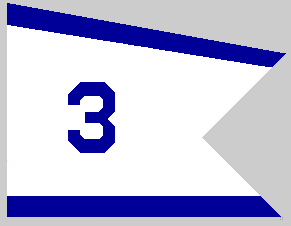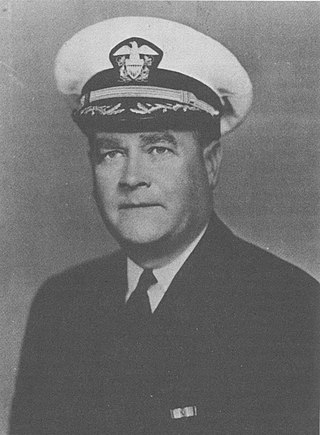
A PT boat was a motor torpedo boat used by the United States Navy in World War II. It was small, fast, and inexpensive to build, valued for its maneuverability and speed but hampered at the beginning of the war by ineffective torpedoes, limited armament, and comparatively fragile construction that limited some of the variants to coastal waters. In the US Navy they were organized in Motor Torpedo Boat Squadrons (MTBRONs).
The Offshore Patrol (OSP) also known as the Mosquito Fleet was a small naval branch of the United States Army, intended for inshore defense of the Commonwealth of the Philippines. It was active from February 9, 1939 to June 30, 1946. The OSP became part of the United States Army Forces in the Far East (USAFFE) on July 26, 1941, with General Douglas MacArthur as Commander. During the Japanese invasion of the Philippines, the Patrol engaged in limited naval operations along the coastlines of Bataan and Corregidor, against the tight enemy blockade, to bring much-needed provisions to the beleaguered Filipino and American troops during the battle. Undaunted by enemy superiority, the ubiquitous patrol boats fought with zeal, courage and heroism, hitting Japanese warships with torpedoes when given the opportunity. The unit relied on speed and surprise to attack larger vessels at close range.

PT-109 was an 80-foot Elco PT boat last commanded by Lieutenant John F. Kennedy, future United States president, in the Solomon Islands campaign of the Pacific theater during World War II. Kennedy's actions in saving his surviving crew after PT-109 was rammed and sunk by a Japanese destroyer earned him several commendations and made him a war hero. Back problems stemming from the incident required months of hospitalization at Chelsea Naval Hospital and plagued him the rest of his life. Kennedy's postwar campaigns for elected office referred often to his service on PT-109.
They Were Expendable is a 1945 American war film directed by John Ford, starring Robert Montgomery and John Wayne, and featuring Donna Reed. The film is based on the 1942 novel of the same name by William Lindsay White, relating the story of the exploits of Motor Torpedo Boat Squadron Three, a United States PT boat unit defending the Philippines against Japanese invasion during the Battle of the Philippines (1941–42) in World War II.

John Duncan Bulkeley was a vice admiral in the United States Navy and was one of its most decorated naval officers. Bulkeley received the Medal of Honor for actions in the Pacific Theater during World War II. He was also the PT boat skipper who evacuated General Douglas MacArthur from Corregidor in the Philippines and commanded at the Battle of La Ciotat.

Motor Torpedo Boat Squadron Three was a United States Navy squadron based at Cavite, Philippines, from September 1941 to mid-April 1942. It was commanded by Lieutenant John D. Bulkeley and made up of six motor torpedo boats: PT-31, PT-32, PT-33, PT-34, PT-35, and PT-41, the last as the squadron flagship. The other six boats of the squadron remained at Pearl Harbor, Hawaii, and were there when war broke out, eventually being shipped to the Solomons.

Patrol torpedo boat PT-41 was a PT-20-class motor torpedo boat of the United States Navy, built by the Electric Launch Company of Bayonne, New Jersey. The boat was laid down as Motor Boat Submarine Chaser PTC-21, but was reclassified as PT-41 prior to its launch on 8 July 1941, and was completed on 23 July 1941. It was used to evacuate General Douglas MacArthur from Corregidor at the beginning of the war in the Pacific in World War II.
Patrol torpedo boat PT-34 was a PT-20-class motor torpedo boat of the United States Navy, built by the Electric Launch Company of Bayonne, New Jersey. The boat was laid down as Motor boat submarine chaser PTC-14, but was reclassified as PT-34 prior to its launch on 14 June 1941, and was commissioned on 12 July 1941.

USS Branch (DD-197) was a Clemson-class destroyer in the United States Navy that entered service in 1920. After a short active life, Branch was placed in reserve in 1922. The ship was activated again for World War II before being transferred to the Royal Navy in 1940. Renamed HMS Beverley, the destroyer served in the Battle of the Atlantic as a convoy escort and was torpedoed and sunk on 11 April 1943.

USS Guest (DD-472), a Fletcher-class destroyer, was a ship of the United States Navy named for Commodore John Guest (1822–1879).

PT-105 was a PT boat of the United States Navy during World War II. The 80-foot (24 m) motor torpedo boat was built by the Elco Motor Yacht Company of Bayonne, New Jersey, in early 1942, and served until the end of the war.

USS Callisto (AGP-15) was a Portunus-class motor torpedo boat tender built for the United States Navy during World War II. It was originally ordered as USS LST-966 an LST-542-class tank landing ship, but renamed and re-designated in August 1944.

USS Alecto (AGP-14) was a Portunus-class motor torpedo boat tender built for the United States Navy during World War II. She was originally ordered as USS LST-977 an LST-542-class tank landing ship, but renamed and re-designated on 12 June 1944.

On 11 March 1942, during World War II, General Douglas MacArthur and members of his family and staff left the Philippine island of Corregidor and his forces, which were surrounded by the Japanese. They traveled in PT boats through stormy seas patrolled by Japanese warships and reached Mindanao two days later. From there, MacArthur and his party flew to Australia in a pair of Boeing B-17 Flying Fortresses, ultimately arriving in Melbourne by train on 21 March. In Australia, he declared, "I came through and I shall return".
Trabajador was a 111 foot (33.8 m) tug launched in 1931 from the Hong Kong and Whampoa Dock for Visayan Stevedore-Transportation Company and registered as a United States vessel in Iloilo, Philippines.

Gilbert Corwin Hoover was a United States Naval officer from 1916 to 1947. He served in both world wars, was involved in the early stages of the development of the Atomic Bomb, and managed the Atomic Energy Commission's Boulder facility as a civilian contractor. He was awarded the Navy Cross three times.

Q-111 Luzon was a motor torpedo boat of the United States Army during World War II as part of the Offshore Patrol based at Manila.
Q-112 Abra was a motor torpedo boat of the United States Army during World War II as part of the Offshore Patrol based at Manila.

Splinter fleet or Splinter navy was a nickname given to the United States wooden boats used in World War II. The boats served in many different roles during the war. These boats were built in small boatyards on the West coast and East coast, Great Lakes and the Gulf of Mexico. They could be built quickly, in just 60 to 120 days. Most of the boats were built by boatyards that already had the tools and knowledge from building yachts, sailboats and motor boats. Many were built by craftsmen in family-owned small businesses. Under the Emergency Shipbuilding Program and War Shipping Administration contracts went out to over fifty boatyards across the country. The boats were built for the US Navy, the United States Army Air Forces, United States Coast Guard, and US Army. Some of the wooden boats went to Allied nations on the Lend-Lease program.











